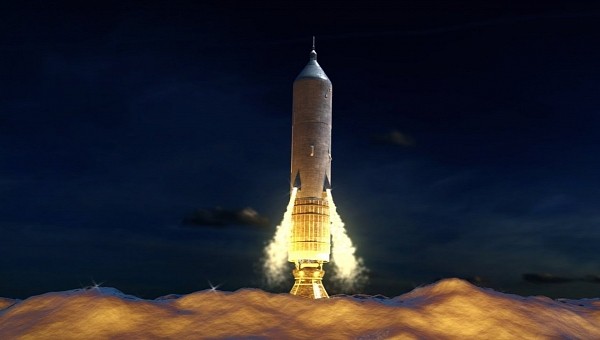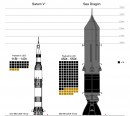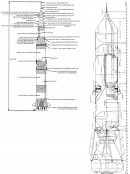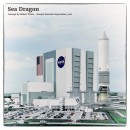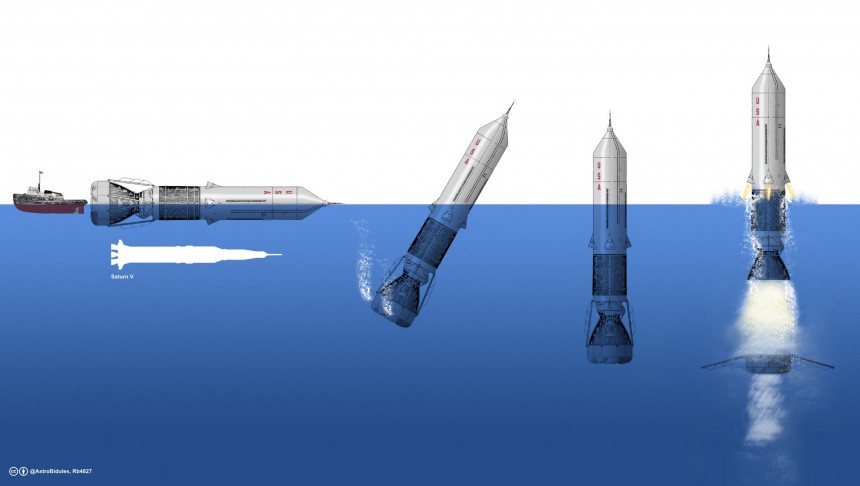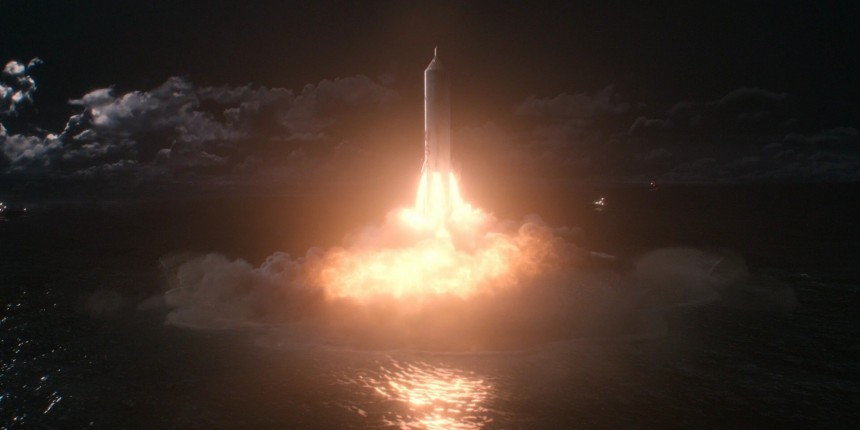It's not often we come across something space related that makes us go "WOW!". But that's the only descriptor fitting to explain the post-credit scene in the last episode of season one of For All Mankind on Apple TV. In this scene, NASA conducts its first test launch of a sea-bound booster rocket that makes the Saturn V look like a Reliant Robin.
The scene starts with what looks like a tiny Apollo Command Module jutting out just above the surface of the Pacific Ocean. But as the countdown reaches zero, massive and unsettling groaning noises surge from beneath the water, causing the greater mass of what lurks beneath to start emerging. Slowly at first, then steadily more rapidly, that tiny command module is borne aloft by a nearly 500-foot tall leviathan of a machine powered by a single, massive main rocket booster sending the craft into the sky.
Because claims like this are nothing without numbers, let's take a look at a tale of the tape. We're gonna need some extra long tape measures this time around. With a diameter of 75 feet (23 m) and a projected height of a staggering 490 feet (150 m), and weighing in at just under 40 million lb (18,143 tons), Sea Dragon was designed like a freight train with a rocket engine.
Its potential to bring 550 metric tons (1,210,000 lb) to low-Earth orbit (LEO) certainly sounds like freight train numbers. That was essentially the idea when the Sea Dragon's lead engineer Robert Traux finalized the blueprints for the design in 1962. Under the employment of the Aerojet company that'd one day merge with Rocketdyne, Traux proposed an alternative to conventional super-heavy booster rockets with lots of complicated engines.
In some ways, the Big Dumb Booster (BDB) design philosophy is nothing short of admirable. As a stark contrast to how modern rockets are designed with sometimes dozens of individual engines, BDBs aim to make the same power with one colossal but simple main engine. Because Sea Dragon would have smashed through the ceiling at NASA's Vehicle Assembly Building, the rocket was to be manufactured sea-side by bespoke shipbuilders and rocket engineers out of cheap 8-mm sheet steel.
When the countdown hit zero, as it did in For All Mankind, the propellant and oxidizer would be forced into the main combustion chamber at roughly 32 atm (3,200 kPa; 470 psi) and 17 atm (1,700 kPa; 250 psi), respectively. All those boring numbers equated to one far larger and more interesting number, a total of 79 million lb (350 mN) of launch thrust from the Sea Dragon's first stage. For some context, the SLS rocket that launched Artemis I back in 2022 jetted 8.8 million lb (39 mN) of thrust at launch.
By the time the first stage fuel in Sea Dragon was expended, the vehicle would be roughly 25 miles (40 km) in altitude at 20 miles (32 km) downrange, flying upwards of 4,000 mph (6,400 km/h; 1.8 km/s). From there, a smaller second stage would take over and separate from the gargantuan first stage. If you can believe it, Robert Traux even mulled the idea of stage recovery and re-use. Considering this was 60 years before SpaceX's Starship and almost a decade before Elon Musk was even born, that's very forward-thinking for the day.
The second stage would have likely used cryogenic liquid hydrogen instead of refined kerosene. Even on its own, the second stage would have beaten the modern SLS in thrust by 4.2 million lbs (18.68 mN). Where the payload in this second stage could have gone is anybody's guess. It's often theorized that the end goal for Sea Dragon was mass cargo transportation to the Moon and possibly even to Mars.
Thus, the Sea Dragon fizzled into vaporware before the Saturn V was even finished. But in the For All Mankind universe, the Sea Dragon did manage to leap from blueprints to our mortal reality. In the show, the first Sea Dragon launched in 1977 and supplied bulk equipment and recourses to the Jamestown Moon Base located at Shackelton Crater near the lunar South Pole.
In 1983, the Soviets believed the Sea Dragon 17 mission was carrying a nuclear warhead to the lunar surface. The crew aboard the fictional Pathfinder spacecraft, commanded by Edward Baldwin, launched missiles at the craft to signal the Soviet Buran crew that the payload wasn't a weapon. By 1995, Sea Dragon was ferrying parts to construct the Sojourner 1 human-crewed Mars landing vehicle, which made it to the Red Planet in season 3.
For what was supposed to be a long-forgotten idea on a drawing board that never saw the light of day, the Sea Dragon made some visual fireworks on Apple TV. If only we lived in the For All Mankind timeline where the Sea Dragon came to life. It sounds like a far more interesting universe to live in.
The largest rocket ever designed
The rocket in question? It's called Sea Dragon, and it's not just another product of Hollywood trying to make rocket science more entertaining than it was in real life. It was a very real-world design study that took place even before the Apollo program had gotten off the ground. Today, let's take a deep dive into the real-life and fictional exploits of Sea Dragon, the most ludicrous design for a booster rocket that never jumped off the drawing board.Because claims like this are nothing without numbers, let's take a look at a tale of the tape. We're gonna need some extra long tape measures this time around. With a diameter of 75 feet (23 m) and a projected height of a staggering 490 feet (150 m), and weighing in at just under 40 million lb (18,143 tons), Sea Dragon was designed like a freight train with a rocket engine.
Its potential to bring 550 metric tons (1,210,000 lb) to low-Earth orbit (LEO) certainly sounds like freight train numbers. That was essentially the idea when the Sea Dragon's lead engineer Robert Traux finalized the blueprints for the design in 1962. Under the employment of the Aerojet company that'd one day merge with Rocketdyne, Traux proposed an alternative to conventional super-heavy booster rockets with lots of complicated engines.
So massive only the sea can contain it
The whole shebang would then be towed by upwards of four ship tugs to a safe distance away from dry land or civilization. From there, Sea Dragon would be stood upright and submerged up to its eyeballs underneath the water. When the time to boogaloo was at hand, ballast tanks attached to the rocket's underside would release, allowing the first stage to ignite. Had Sea Dragon's main engine been manufactured, its first stage would have run on a potent cocktail of RP-1 refined kerosene and LOX (liquid oxygen) as an oxidizer.When the countdown hit zero, as it did in For All Mankind, the propellant and oxidizer would be forced into the main combustion chamber at roughly 32 atm (3,200 kPa; 470 psi) and 17 atm (1,700 kPa; 250 psi), respectively. All those boring numbers equated to one far larger and more interesting number, a total of 79 million lb (350 mN) of launch thrust from the Sea Dragon's first stage. For some context, the SLS rocket that launched Artemis I back in 2022 jetted 8.8 million lb (39 mN) of thrust at launch.
By the time the first stage fuel in Sea Dragon was expended, the vehicle would be roughly 25 miles (40 km) in altitude at 20 miles (32 km) downrange, flying upwards of 4,000 mph (6,400 km/h; 1.8 km/s). From there, a smaller second stage would take over and separate from the gargantuan first stage. If you can believe it, Robert Traux even mulled the idea of stage recovery and re-use. Considering this was 60 years before SpaceX's Starship and almost a decade before Elon Musk was even born, that's very forward-thinking for the day.
Step aside Starship, here's your daddy
Plans were even put in place between Aerojet, NASA, and the West Coast-based Todd Shipyards to start work on the project. But sadly, NASA's titanic 2.5 percent share of national GDP during the Apollo program still wasn't enough to fund their human-crewed Moon landing ambitions and this flight-of-fancy space vehicle simultaneously. In the end, an outside adjudication by the aerospace firm TRW Inc confirmed Sea Dragon wasn't in the cards financially.Thus, the Sea Dragon fizzled into vaporware before the Saturn V was even finished. But in the For All Mankind universe, the Sea Dragon did manage to leap from blueprints to our mortal reality. In the show, the first Sea Dragon launched in 1977 and supplied bulk equipment and recourses to the Jamestown Moon Base located at Shackelton Crater near the lunar South Pole.
In 1983, the Soviets believed the Sea Dragon 17 mission was carrying a nuclear warhead to the lunar surface. The crew aboard the fictional Pathfinder spacecraft, commanded by Edward Baldwin, launched missiles at the craft to signal the Soviet Buran crew that the payload wasn't a weapon. By 1995, Sea Dragon was ferrying parts to construct the Sojourner 1 human-crewed Mars landing vehicle, which made it to the Red Planet in season 3.
